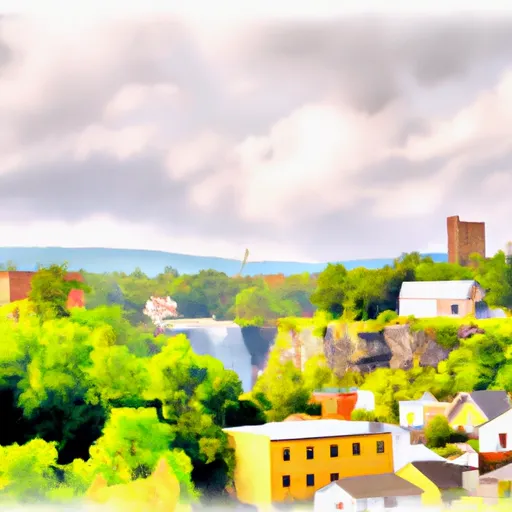-
 Snoflo Premium
Snoflo Premium
Get unlimited access to all our content
With no Ad interruptions! - Start Your Free Trial Login with existing account
Waterfall
Eden Index
Climate
8.1
•
Recreation
3.1
•
Community
1.6
•
Safeguard
4.7/10

Waterfall, Pennsylvania is a picturesque town located in Bedford County. The region experiences a humid continental climate, characterized by warm summers and cold winters. Average temperatures in summer range from 70°F to 80°F, while winter temperatures can drop below freezing, with occasional snowfall.
Situated near the Raystown Lake, Waterfall benefits from abundant water resources. The hydrology constituents of this area include streams, creeks, and the Juniata River, which provide opportunities for various water-related activities. Fishing enthusiasts can try their luck with species such as bass, catfish, and trout, while boating and swimming are popular summer pastimes.
Waterfall is surrounded by beautiful natural landscapes, making it a haven for outdoor enthusiasts. The nearby Buchanan State Forest offers miles of trails for hiking, mountain biking, and horseback riding, allowing visitors to immerse themselves in the tranquil beauty of nature. Hunting is also permitted during designated seasons.
In conclusion, Waterfall, Pennsylvania offers a diverse climate with distinct seasons, abundant hydrology constituents, and a range of outdoor recreation opportunities. From fishing and boating to hiking and hunting, this charming town has something to offer for every nature lover.
What is the Eden Index?
The Snoflo Eden Index serves as a comprehensive rating system for regions, evaluating their desirability through a holistic assessment of climate health, outdoor recreation opportunities, and natural disaster risk, acknowledging the profound impact of these factors on livability and well-being.
Climate Health Indicator (CHI): 8.1
Waterfall receives approximately
1017mm of rain per year,
with humidity levels near 83%
and air temperatures averaging around
11°C.
Waterfall has a plant hardyness factor of
6, meaning
plants and agriculture in this region thrive during a short period during spring and early summer. Most
plants will die off during the colder winter months.
By considering the ideal temperature range, reliable water supplies, clean air, and stable seasonal rain or snowpacks, the Climate Health Indicator (CHI) underscores the significance of a healthy climate as the foundation for quality living.
A healthy climate is paramount for ensuring a high quality of life and livability in a region, fostering both physical well-being and environmental harmony. This can be characterized by ideal temperatures, reliable access to water supplies, clean air, and consistent seasonal rain or snowpacks.
Weather Forecast
Streamflow Conditions
Lower Susquehanna
Area Rivers
Lower Susquehanna
Snowpack Depths
Lower Susquehanna
Reservoir Storage Capacity
Lower Susquehanna
Groundwater Levels
Recreational Opportunity Index (ROI): 3.1
The Recreational Opportunity Index (ROI) recognizes the value of outdoor recreational options, such as parks, hiking trails, camping sites, and fishing spots, while acknowledging that climate plays a pivotal role in ensuring the comfort and consistency of these experiences.
Access to outdoor recreational opportunities, encompassing activities such as parks, hiking, camping, and fishing, is crucial for overall well-being, and the climate plays a pivotal role in enabling and enhancing these experiences, ensuring that individuals can engage in nature-based activities comfortably and consistently.
Camping Areas
| Campground | Campsites | Reservations | Toilets | Showers | Elevation |
|---|---|---|---|---|---|
| Fort Frederick State Park | 29 | 386 ft | |||
| Trough Creek State Park | None | 963 ft | |||
| Seven Points | 261 | 888 ft | |||
| Sleepy Creek WMA | 75 | 1,157 ft | |||
| McCoys Ferry - C and O Canal National Park | 14 | 377 ft | |||
| Canoe Creek State Park | None | 914 ft | |||
| Cowans Gap State Park | None | 1,223 ft | |||
| Susquehannock - Raystown Lake | 60 | 867 ft | |||
| Black Moshannon State Park | None | 1,882 ft |
Nearby Fishing
Nearby Ski Areas
Catastrophe Safeguard Index (CSI):
The Catastrophe Safeguard Index (CSI) recognizes that natural disaster risk, encompassing floods, fires, hurricanes, and tornadoes, can drastically affect safety and the overall appeal of an area.
The level of natural disaster risk in a region significantly affects safety and the overall livability, with climate change amplifying these risks by potentially increasing the frequency and intensity of events like floods, fires, hurricanes, and tornadoes, thereby posing substantial challenges to community resilience and well-being.
Community Resilience Indicator (CRI): 1.6
The Community Resilience Indicator (CRI) recognizes that education, healthcare, and socioeconomics are crucial to the well-being of a region. The CRI acknowledges the profound impact of these elements on residents' overall quality of life. By evaluating educational resources, healthcare accessibility, and economic inclusivity, the index captures the essential aspects that contribute to a thriving community, fostering resident satisfaction, equity, and social cohesion.

